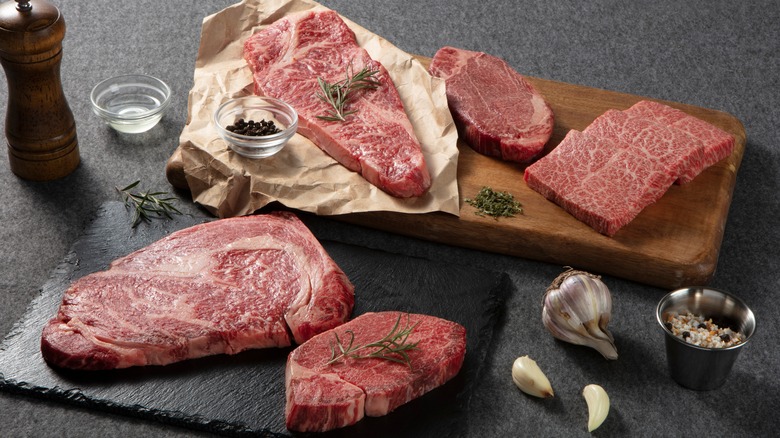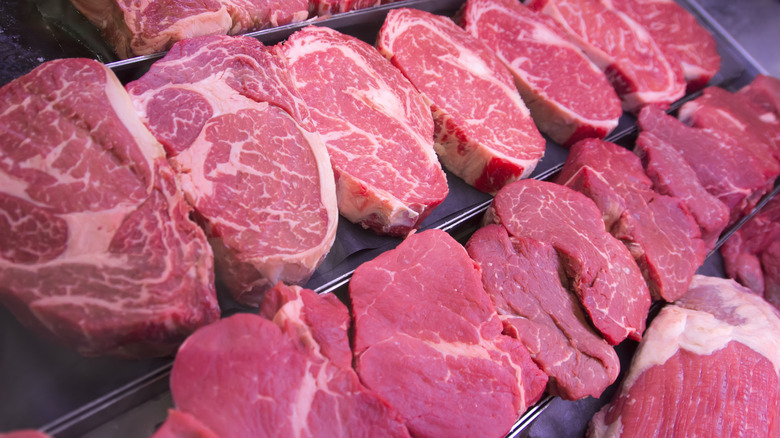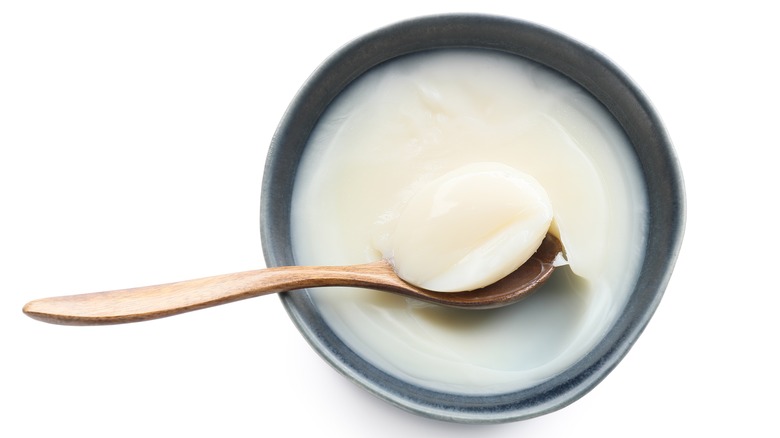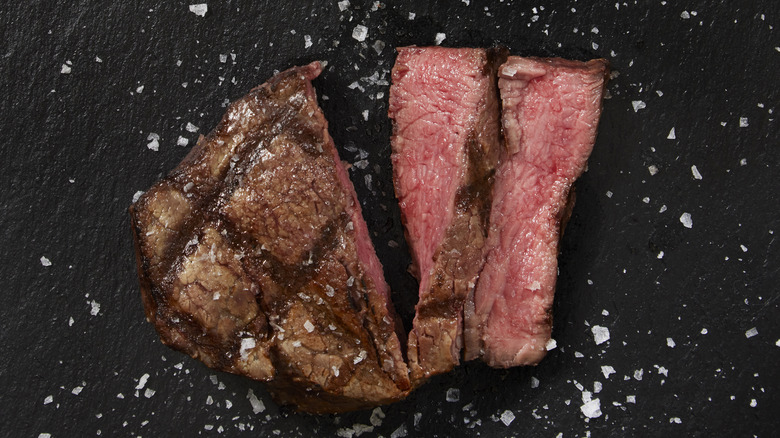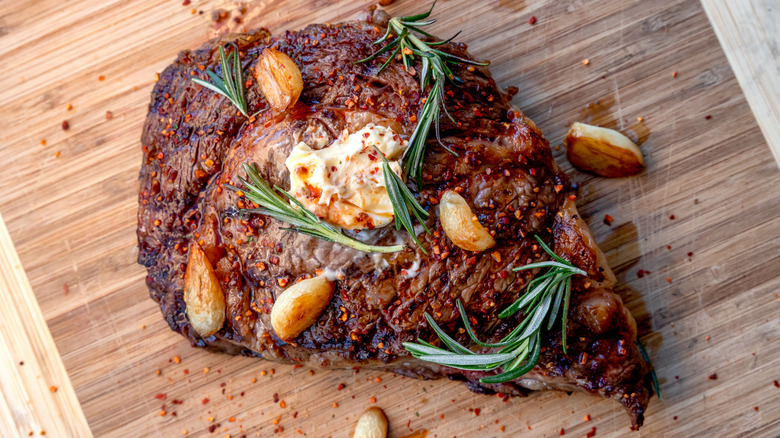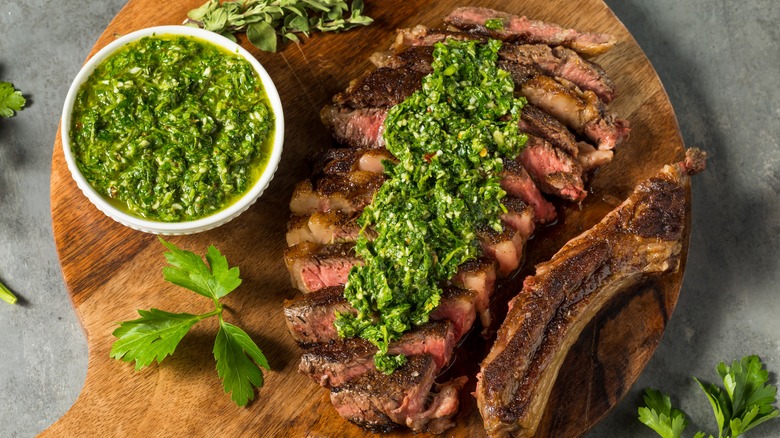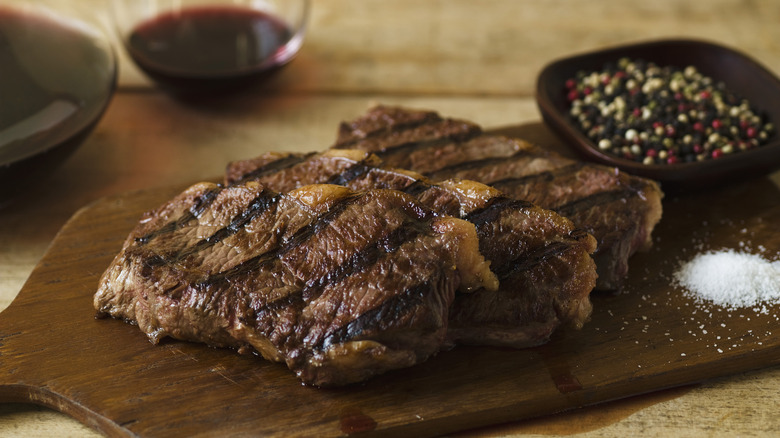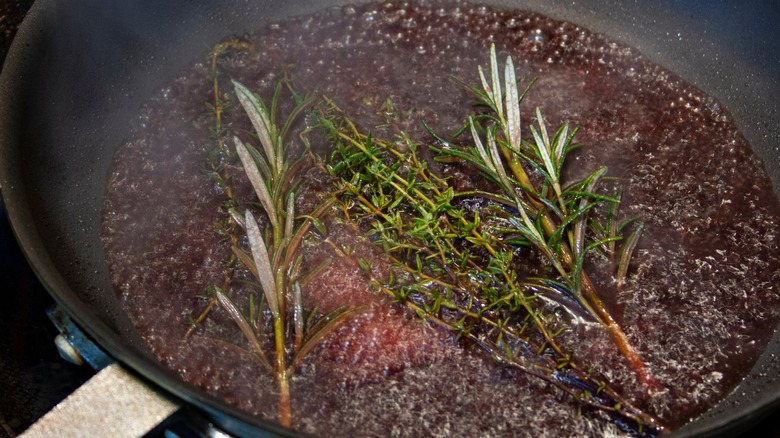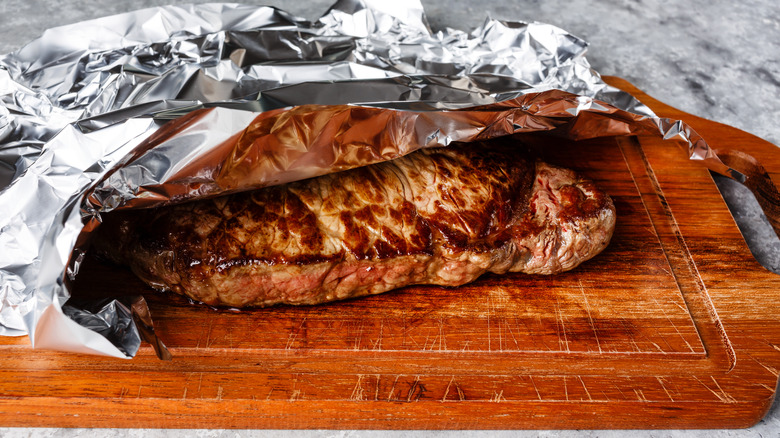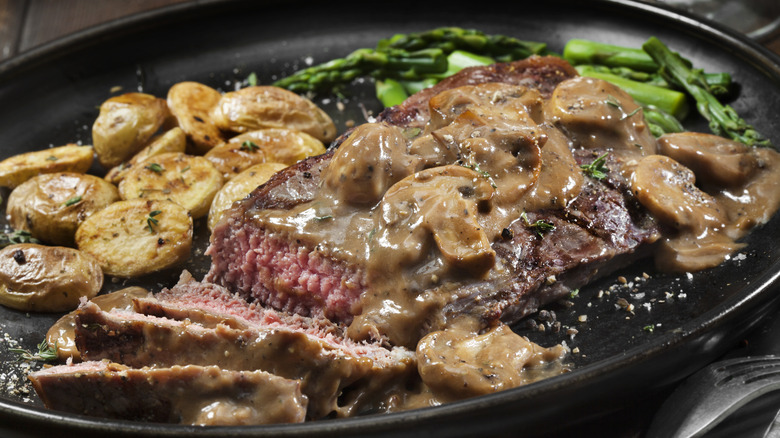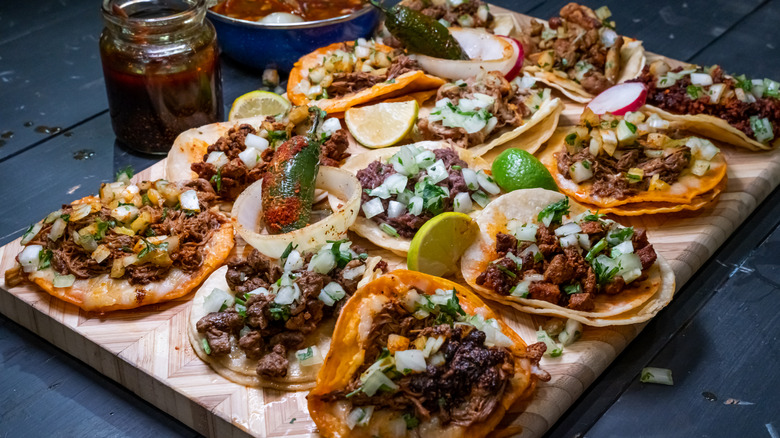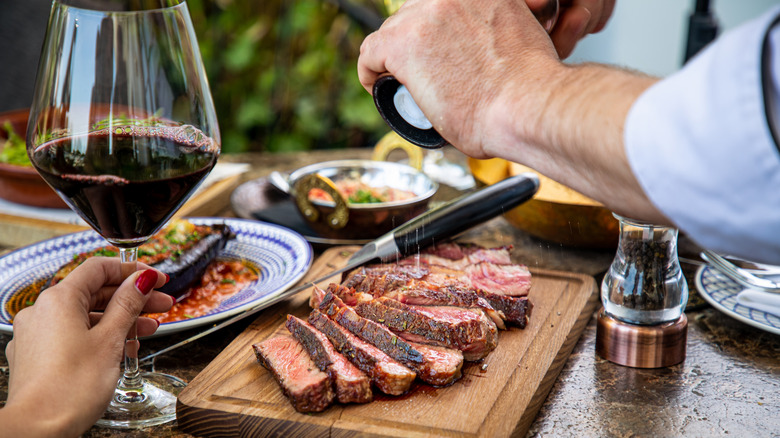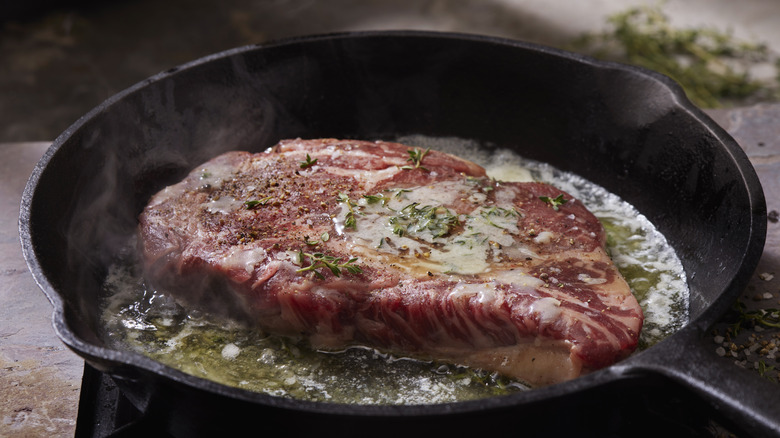12 Simple Additions To Take Steak To Another Level
Whether you're grilling in the garden or cooking in the kitchen for a casual summer bite or a sophisticated date night dinner, you can't go wrong with steak. Vegans might not agree with that statement, but pretty much everyone else will never say no to a beautifully cooked steak. Often one of the priciest items on a restaurant menu, steak is worth learning how to cook for yourself. It carries a certain gravitas and promise, so it's understandable to be intimidated. But fear not; cooking steak doesn't have to be complicated if you're not used to making it at home. While there is a lot to learn and ways to elevate your steak dinner with skillful techniques and sauces, sometimes the simplest steak is the best.
We spoke with Paris Hunter Paul, steak aficionado, pop-up chef, and former kitchen manager at Los Angeles's erstwhile trendy twin restaurants Kettle Black and Sawyer, about the best ways to get the most out of your red meat and take your steak to the next level. Paul currently runs the popular Silverlake Backgammon Club and Provisions, which hosts pop-up events in collaboration with hip bars and restaurants across Los Angeles. Pairing good food, friends, and drinks is his forte and passion. When it comes to hosting the ultimate dinner, from the open flame to the cast iron skillet, Paul assures us there's nothing better than a good steak cooked right.
Add inches
The easiest thing you can add to your steak is inches! Paul recommends going for that thicker cut. It might cost a little more, but you'll get more out of it, and it's easier to cook a slightly bigger steak without running the risk of overcooking the meat. "Your steak is going to cook so much nicer," says Paul, and "is going to have a better mouth feel with a good crust and a nice pink and juicy center." Plus, you won't be mad at the leftovers come lunchtime tomorrow.
When it comes to choosing your cut, chef Michael Simon has some recommendations. And Paul says as far as he's concerned, ribeye is king. "You want good marbling," he says. "And you know, don't be afraid of fat." That fat is what gives steak its beefy flavor. In a good cut like ribeye, the fat will be marbled throughout the steak, and it'll be soft and tasty, not gristly or chewy. If you slice it up nicely before plating, you can serve more people with less meat. And if you're cooking for one, use the leftovers to make a delicious steak sandwich or steak salad the next day. Do the work today and reap the benefits tomorrow.
Fat is your friend
If you're pan-searing a steak, the best way to get a nice crust on the meat and preserve the flavor is to cook it in fat. That's right, leave the oil on the counter and reach for some beef tallow and butter instead. It might sound decadent, but beef fat is healthier than you think. Paul assures, "Beef fat is a great source of vitamins and minerals and energy and flavor." And anyway, when you're making steak dinner, is calorie counting really the priority? Go all in on deliciousness.
When cooking a steak, Paul says people usually don't think to add more fat from the animal, but it's his method of choice. Some gourmet grocery stores will sell beef tallow by the jar, but if you don't have one in your neighborhood (or you don't want to pay their markup), stop by the butcher counter. Paul recommends asking the butcher for some extra fatty beef trimmings. You can render that down on your own. We're venturing into chef territory here, but it's pretty easy. Pop the trimmings in a pan and slow cook until the fat renders out. Then strain it through a fine metal strainer or even a paper coffee filter, and you'll be left with a jar of your own beef tallow. Then heat some in a pan next time you cook a steak and baste the meat every time you flip it. The tallow can also be used to cook other things or even fry an egg.
Know when to salt
There's chemistry at work when you salt meat. Salt draws out moisture, so you have to know when to do it for best results. Paul says people are often salting their steaks too early or too late. "Moisture is your enemy when it comes to steak," he says. Why is moisture the enemy? You're trying to achieve the Mailliard reaction to get a nice crust, but you can't do that in a pool of liquid. Salt is going draw out moisture, "So no matter what, you're going to want to be patting your steak dry," says Paul. Because if it's wet in the pan you'll prevent the proteins from breaking down and crystallizing. "That crystallization builds that beautiful crust and you're not going to get that if essentially all those proteins are dissolving in steam and moisture and water."
Braising is a great technique for other tougher cuts of beef but not for searing your expensive steak. Make sure to pat it dry before popping it in the hot pan. Salting a day in advance with kosher salt allows the meat to reabsorb the moisture. If you don't have time, Paul recommends waiting and salting just before cooking. And salt again before serving with a nice finishing salt that will give it flavor and a little crunch.
Throw some garlic and sturdy herbs into the pan
Garlic is a flavorful friend to steak. Whether it's in the form of garlic butter, garlic salt, or whole cloves of garlic, you can introduce this ingredient right into the cooking process or add it to a sauce or seasoning garnish. Likewise, a sprig or two of rosemary can make a big impact.
When you're cooking steak in a pan on the stove, you can throw a few crushed cloves of garlic or a bouquet of herbs right into the hot fat or butter. These flavors will infuse into the cooking process. As long as you don't mince them up, garlic and herbs like rosemary and thyme won't just burn up in the heat. What Paul calls a "sturdy herb" leeches its essential oils and flavor into the hot butter or beef fat. These powerful flavors can take your steak to a whole new level, and it's as easy as tossing them into the pan. You can echo these flavors in a side dish like roast potatoes.
Garnish with delicate herbs.
More delicate leafy herbs like cilantro and parsley are just going to burn if you put them right into a hot pan. These flavors are best left to the end, or perhaps they might pop up in a marinade that will be wiped off before hitting the grill. You can garnish your steak with herbs for a pop of color and a hint of flavor, or you can incorporate them into a sauce.
Chimichurri is a classic Argentine steak sauce that has become an international favorite. Much like pesto, chimichurri is made from pounding finely diced herbs with garlic, oil, and seasoning. Traditionally, chimichurri uses a combination of parsley, cilantro, and chilies blended with olive oil and red wine vinegar. You can make it spicy if you like by selecting hotter chilies. Serve it on the side or spooned over sliced grilled steak. This bright and zesty sauce is a beautiful way to add some color and fresh flavor to your next steak night. It also tastes great on grilled vegetables.
Pepper it up
Next to salt, you'll always find pepper. And pepper is among the most classic and simple additions to steak out there. Pepper does go well with steak, but Paul says, "Beware of adding too much pepper if you're cooking over an open fire." Pepper can burn, he cautions, and while some people like that charred and smoky flavor, if you don't personally enjoy biting into burned bits of peppercorn, pay attention to the heat level to avoid burning. That makes sense, right? Besides, you can always add a grind of fresh pepper at the end.
A shaker full of ground black pepper or a grinder of whole black peppercorns can be on offer when you're serving up the steak. A lot of steakhouses will also have peppercorn sauce on the menu. If you're interested in experimenting with different peppercorns, try this green peppercorn sauce recipe. Adding pepper to a sauce is another great way to incorporate this flavor without burning the pepper during the process of cooking the steak.
Make a pan sauce with stock
There are lots of steak sauces lining shelves at your local grocery store. But if you want to take your skills up a notch, why not make your own sauce from scratch? A lot of recipes, like this four-ingredient Worcestershire steak sauce, can be very easy to make. And often, the easiest and most delicious sauce is a pan sauce. This is essentially a thin gravy you make right in the same pan you cooked the steak in. Do this with a little beef stock or even chicken broth. The sauce you make will keep your steak nice and moist, super flavorful, and even add some heat back to the dish when you're ready to serve it up.
When the steak is ready, take it off the heat. Then, pour a little stock into the hot pan. This process, called deglazing, will release the little brown bits of meat that are stuck to the bottom of your pan. Those bits of steak will add flavor to the sauce. You can also add some herbs, pepper, shallots, or garlic at this stage. To get that perfect, slightly thicker, velvety texture, Paul explains that you need to reduce stock or broth down in the pan until it's much more concentrated, then when the liquid has reduced and thickened, "throw in a couple knobs of butter and emulsify that on low heat and all of a sudden...you have like a little French sauce." Trés gourmet!
Take your time
While you're making your pan sauce, let the steak rest on a cutting board. That's right, red meat needs to rest for a minute before you slice it up and serve it. Whether you're aiming for rare or medium (any chef will tell you not to go well done with a nice steak), you have to let it rest. Paul explains that you should pull it off the stove or the fire sooner than you would think, which allows the heat to carry over. That means undercooking slightly and letting it finish off heat. Let the steak's proteins reabsorb the juices before slicing into it. "You don't want that juice in the pan," Paul says. "You want the juice in each bite of the steak, and you get that by letting the meat rest."
You can tent the steak with foil while it rests to keep the heat in. Cutting into a steak too soon will release the juices out onto the plate. And if some juices do run out while you're resting it, you can pour those back into the pan and reincorporate them into the sauce. When it comes to getting the perfect bite, "even if it's a little bit colder than you would like," Paul assures. "It'll still be a much more pleasant dining experience than just biting into it, all of the juice falling out, and having it be a little bit more tough." Plus, that nice pan sauce will add some heat back onto your plate.
Mushrooms are a steak's best friend
Steak can be served with almost anything. In a restaurant you'll often see a classic steak frites, or perhaps a caesar salad. Potatoes and hearty winter vegetables pair nicely, equally summer squash and spicy arugula salad. But one of the most common pairings is steak and mushroom. "Mushrooms are a steak's best friend," says Paul. The mushrooms can be served on the side, or you can add mushrooms into a pan sauce to add some extra umami flavor and a nice bite.
Many steakhouses will offer a mushroom sauce option. But if you like to keep your meat simple and let it speak for itself, sauté some mushrooms and serve them up as a side dish. Mushrooms are very much of the moment, and you can find all kinds of different shapes, sizes, and textures these days. A classic cremini will do the trick, but why not experiment with maitake mushrooms next time?
Sugar is the perfect shortcut
We don't always think about sweetness when making savory foods, but balanced flavors often include a pinch of sugar. And when it comes to making a leaner cut of steak, sometimes a little sugar goes a long way towards adding that perfect finish. Many classic steak sauces and marinades, like barbecue or teriyaki sauce, include sugar. A nice thin cut like a flank steak or skirt steak can be a great alternative to more expensive cuts when you're cooking for a party. These cuts are perfect for making steak tacos. Keep in mind, however, that thin steaks don't have a lot of fat. The addition of sugar, explains Paul, helps induce caramelization when fat is lacking.
A healthy and flavorful alternative to sticky, sugary sauces is fruit juice. A lot of great marinades, like a carne asada marinade, for instance, include lime juice, orange juice, or even pineapple juice. You can mix citrus with herbs, vinegar, or even soy sauce and let the steak marinate in the mixture for at least a couple of hours, up to overnight. Just make sure you pat it dry again when you're ready to cook so you can benefit from the flavor and sugars without too much moisture to disrupt that caramelization.
Sip some red wine
Red wine is another ubiquitous companion to steak. It's not uncommon to see a red wine sauce offered with a nice piece of beef. You can deglaze a pan with a splash of red wine as much as you can with stock. Red wine also pops up as an ingredient in many beef stews and braises. You can cook with that bottle of wine you never got to finish last week and add some depth to your next brisket or pot roast.
When it comes to serving up a perfect steak, however, Paul recommends keeping the wine separate. There's lots of talk out there about which wines pair perfectly with certain foods, but there's no question that red wine goes well with steak. Which red wine exactly? Well, ultimately, it's up to your own preference. So grab your favorite bottle and serve a nice glass of red wine with the meal. Sip between bites and enjoy how the flavors blend on your palate, but don't pour it onto the plate!
Baste with butter
Basting with butter is a great technique if you're cooking your steak on the stove. We've already established that it is preferable to use beef fat, but even then, you'll probably want to add some butter at the end. "Butter will add a ton of flavor to the steak," Paul says, and it will help with caramelization on the outside. But butter can burn, so he cautions us only to use it at the end of a high-heat searing process or during low-heat reverse sear cooking. Butter is good to introduce in lower heat because that way, the milk solids won't burn.
When you're cooking steak in a skillet with lots of butter, Paul recommends being generous with the drippings and basting constantly. And if you want to play with flavors, you can use herbed butter. Then use more butter to make your pan sauce. This buttery 4-ingredient steak sauce could be the perfect finishing touch to your next decadent steak dinner.
